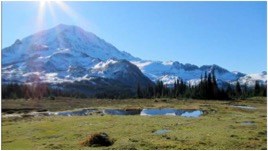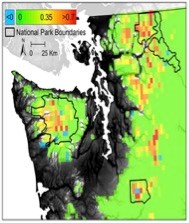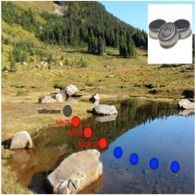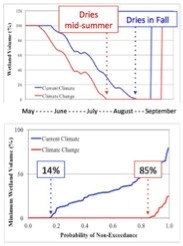Last updated: August 28, 2017
Article
Modeling climate change effects on the hydrology of North Cascades wetland ecosystems

Importance
The purpose of this study is to develop the first models of Mount Rainier wetland ecosystem response to climate change. This study is part of a broader effort to forecast the impacts of climate change on wetland ecosystems in the Pacific Northwest, and to develop climate adaptation strategies for vulnerable wetland types and assemblages such as amphibians.
Wetlands are globally important, but understudied ecosystems. In the Mount Rainier National Park and other regions of the Cascade Range, wetlands range from large low-elevation riparian wetland complexes to high-elevation ponds and lakes. Wetland ecosystems provide important habitat and food for many species from invertebrates to amphibians to carnivores. Montane wetlands also provide water storage for lower-elevation regions outside the Park. In general, wetlands are considered highly sensitive to climate change. The Cascades region is particularly sensitive to climate change, and is already experiencing shifts in the timing of snowfall and snowmelt, soil moisture stress, and recharge. These changes in hydrologic response will result in systematic changes in the timing and duration of water available to wetland wildlife and plants. Our study fills an important knowledge gap by developing the first forecasts of climate impacts on Cascades wetlands. By modeling how wetland dynamics may change in future decades and their potential impacts on wildlife, we hope to enhance the management capacity of Mount Rainier and other regional National Parks to preserve their rich natural heritage. For example, our maps and models may help NPS managers identify species and wetland types at greatest risk, and decide how to allocate resources for climate adaptation accordingly.

Study Area
Our study focuses on the three National Parks in Washington State: North Cascades, Mount Rainier, and Olympic National Parks.
Methods
We monitored pond hydrology (water levels, drying rates) by physical monitoring and temperature dataloggers installed in depth transects from the terrestrial edge to deep in the pond. Because day-tonight air temperature variation is greater than underwater temperature variation, we can interpret changes in the coefficient of variation in temperature relative to changes in depth. We are now using hydrologic data to update and calibrate hydrologic models of wetland dynamics. Using these models, we can then simulate the effects of climate change on wetland hydrology. We are also collecting data on the associations between amphibian species and different wetland types in order to relate changes in wetland habitat to ecological implications for wetland species assemblages like pond-breeding amphibians.

Application to Management
The National Park Service is mandated to develop climate adaptation strategies for managing natural resources in light of climate change. Our work seeks to inform the development of adaptation strategies for increasing the resilience of native wetland assemblages to climate change. In Mount Rainier National Park and many other regions of the American West, wetland ecosystems have already been affected by the introduction of fish (mostly trout) into high elevation regions that were formerly fishless. Predatory introduced fish generally occupy large, deep lakes, and force native amphibians and invertebrates into shallower, smaller wetlands that appear to be disproportionately vulnerable to climate change. In areas where climate change may eliminate many of the wetland habitats on which amphibians currently rely, targeted removals of introduced fish may offer an effective strategy for restoring resilience of native wetland ecosystems to climate change. Our climate projections can be used to direct fish removals towards high-priority areas where the joint effects of climate change and fish are greatest.

Results
Our preliminary analyses show that the effects of climate change on montane wetlands are likely to result in earlier and faster rates of wetland drawdown, reduced overall water availability, increased frequency of pond drying, and a longer dry period in summer. Changes in wetland dynamics are forecast to be greatest in mountain watersheds that shift from having the majority of annual precipitation fall as snow to those dominated by rain. Our preliminary results suggest that seasonal ponds and shallow perennial wetlands that are important for pond-breeding amphibians (e.g. Cascades frogs, long-toed salamanders) are at greatest risk of climate-induced habitat change and loss.
Related studies
There are no similar studies of climate impacts on wetlands in the Pacific Northwest. However, analogous work forecasting climate impacts on Pacific Northwest rivers and streams is available from the Climate Impacts Group at University of Washington.
Suggested reading
For a summary of our work, see: http://www.ecoadapt.org/workshops/pnw- wetlands-symposium Burkett, V.R. and J. Kusler. 2000. Climate change: potential impacts and interactions in wetlands of the United States. J American Water Resources Association 36:313-320. Erwin, K.L. 2009. Wetlands and global climate change: the role of wetland restoration in a changing world. Wetlands Ecology and Management 17:71-84. Winter, T.C. 2000. The vulnerability of wetlands to climate change: a hydrologic landscape perspective. J American Water Resources Association 36:305-311.
Meet the Researchers
Maureen Ryan, Alan Hamlet, and Se-Yeun Lee (Figure 5) are three of the six co- founders of the Wetlands Adaptation Group, a multi-disciplinary group of researchers and practitioners working to advance the science and conservation of wetlands in the face of climate change. Maureen is a population biologist, Smith Conservation Research Fellow at the University of Washington, and adjunct faculty at Western Washington University. She studies the effects of hydrology, climate change, and species interactions on pond-breeding amphibians. Alan Hamlet is a hydrologist and Assistant Professor at the University of Notre Dame. Se-Yeun Lee is a postdoctoral researcher with the Climate Impacts Group at University of Washington. Alan and Se- Yeun have been studying climate-induced hydrologic change and its impacts on Pacific Northwest rivers, and now wetlands, for over a decade. Noll Steinweg, Mara Healy, Rae Parks, and Reed McIntyre are undergraduate field research assistants extraordinaire from Western Washington University who spent months of 2012 in the Mount Rainier, North Cascades, and Olympics backcountry monitoring ponds and counting amphibians.

